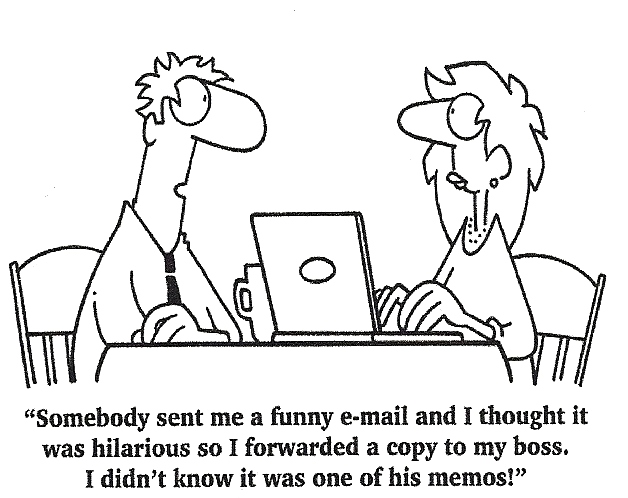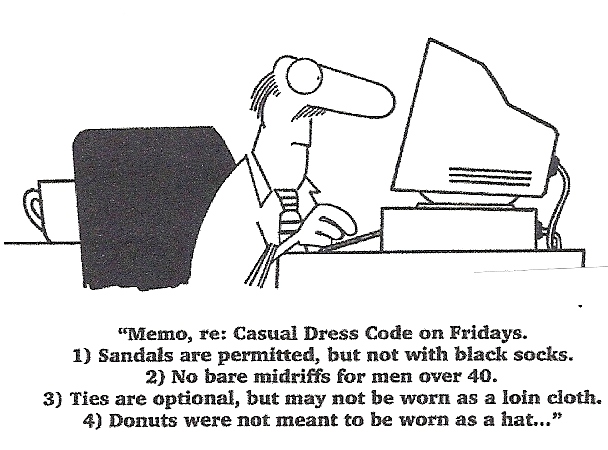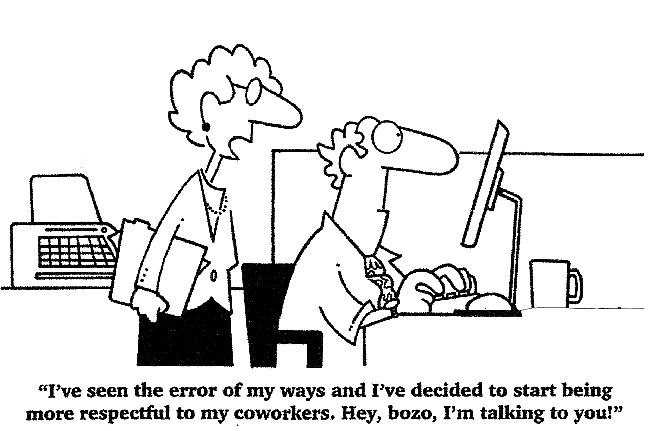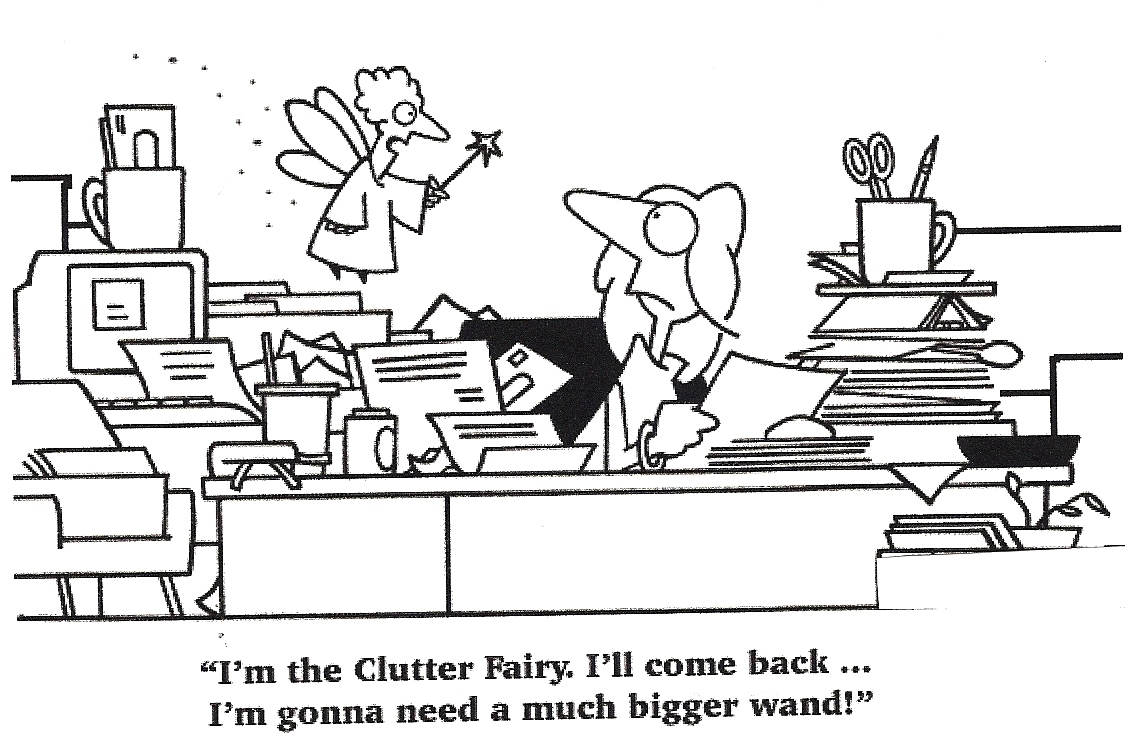
- •Improving Communications
- •Oral communications
- •Written communications
- •7 Tips to become a Good Conversationalist
- •Six Common Mistakes That Spoil Conversations
- •1. Blabbermouthing
- •2. The "take-away" and "me-too" syndrome
- •3. Unsolicited advice
- •4. Interrupting
- •5. Contradicting
- •6. Stingy contributors
- •8 Правил знайомства з діловими партнерами
- •18 Ways to improve your body language
- •6 Чарівних букв
- •Voice and Language
- •Visual aids
- •Fail to prepare
- •No weak opening
- •When I know I have to make a presentation, even a small one before a very limited number of people, I start feeling nervous…
- •When a big meeting is coming up, one that will involve a number of presentations from a range of people…
- •I would say my ability as a presenter is…
- •While I am up on stage, I…
- •Comments about my presentations are generally…
- •If I have to go “off the cuff”…
- •If I could describe public speaking as a food, it would be…
- •Visual aids versus handouts
- •Я к вдало провести ділову зустріч.
- •Introducing the Agenda
- •Introducing the First Item on the Agenda
- •1. What is the desired outcome of the meeting? (How will you know the meeting was successful?)
- •2. Who needs to be there? (And who doesn’t?)
- •3. Is the agenda prepared? (If not now, when?)
- •4. What can I do to prepare? (How can I help others prepare?)
- •5. What can I do to make this meeting succeed? (What is my responsibility?)
- •Discuss the following questions:
- •Exercise 6
- •Negotiating
- •Well, we could make it 7,5 % .
- •The trouble is, the general manager isn't very interested in marketing. He's only concerned about …..5…... If you make it 10%, I might be able to persuade him.
- •But you said…
- •6 Найпоширеніших помилок при проведенні переговорів
- •Communicating with someone in writing
- •The salutation
- •The subject title
- •The body of the letter
- •The parting
- •The signature
- •Inquiries (Enquiries)
- •Поради при написанні ділових листів
- •……………: Always proofread and edit your letters.
- •Avoid the use of …..1….. Words
- •Informal Style Formal Style
- •Identify yourself, if necessary
- •Include necessary information
- •Ten keys to writing an essay
- •Budget your time carefully
- •Read the topic carefully
- •Plan your essay before you write
- •Be sure your handwriting is as clear and legible as possible
- •Follow a clear, logical organization
- •Topic Type a: Contrast/Opinion
- •Use concrete examples and specific reasons
- •Use signal words to indicate transitions
- •Use a variety of sentence types.
- •Check your essay for errors.
- •Електронна пошта
- •Chief, Guy, Sport
- •My Buddy
- •Assumption Junction
- •Peak-a-Boo
- •2 (Suggested answer)
- •Listening 4
- •Contents
- •References
Use concrete examples and specific reasons
Whenever you make a general statement, you should support it with specific examples. Don't just say "Computers are important to modern business." Give specific examples of how computers can benefit businesses. If you state an opinion, give reasons. Don't just say "I believe television is harmful to children." Explain exactly why you think television hurts children.
Use signal words to indicate transitions
Signal words can be used to join paragraph-to-paragraph and sentence-to-
sentence. These words make your essay clearer and easier to follow. Some of
these expressions and their meanings are given below:
First,… The first example is. ... The first reason for this is that…. In addition…. Furthermore …. Moreover… However… On the other hand … Nevertheless… Therefore … Consequently …. Thus ... Likewise …. Similarly … In conclusion…. In summary …
Use a variety of sentence types.
Good writing in English consists of a more-or-less equal balance between short, simple sentences consisting of only one clause and longer sentences containing two or more clauses. Therefore, make an effort to use sentences of various lengths.
You should also vary sentence structures. Begin some sentences with prepositional phrases or subordinate clauses.
Check your essay for errors.
Allow a few minutes to proofread your essay. However, don't make any major changes at this time. Don't cross out long sections or try to add a lot of new material. Look for obvious errors in punctuation, spelling, and capitalization, as well as common grammatical mistakes: subject-verb agreement, wrong verb tenses, incorrect use of plurals, incorrect word forms, and so on.
Good luck in your essay writing!
![]()
Task 1
Imagine that your managing director has asked to you investigate the health and safety provisions in your company’s offices and to make recommendations for improvement.
These are the notes that you’ve made. Draft a report to your MD by expanding the notes into paragraphs.
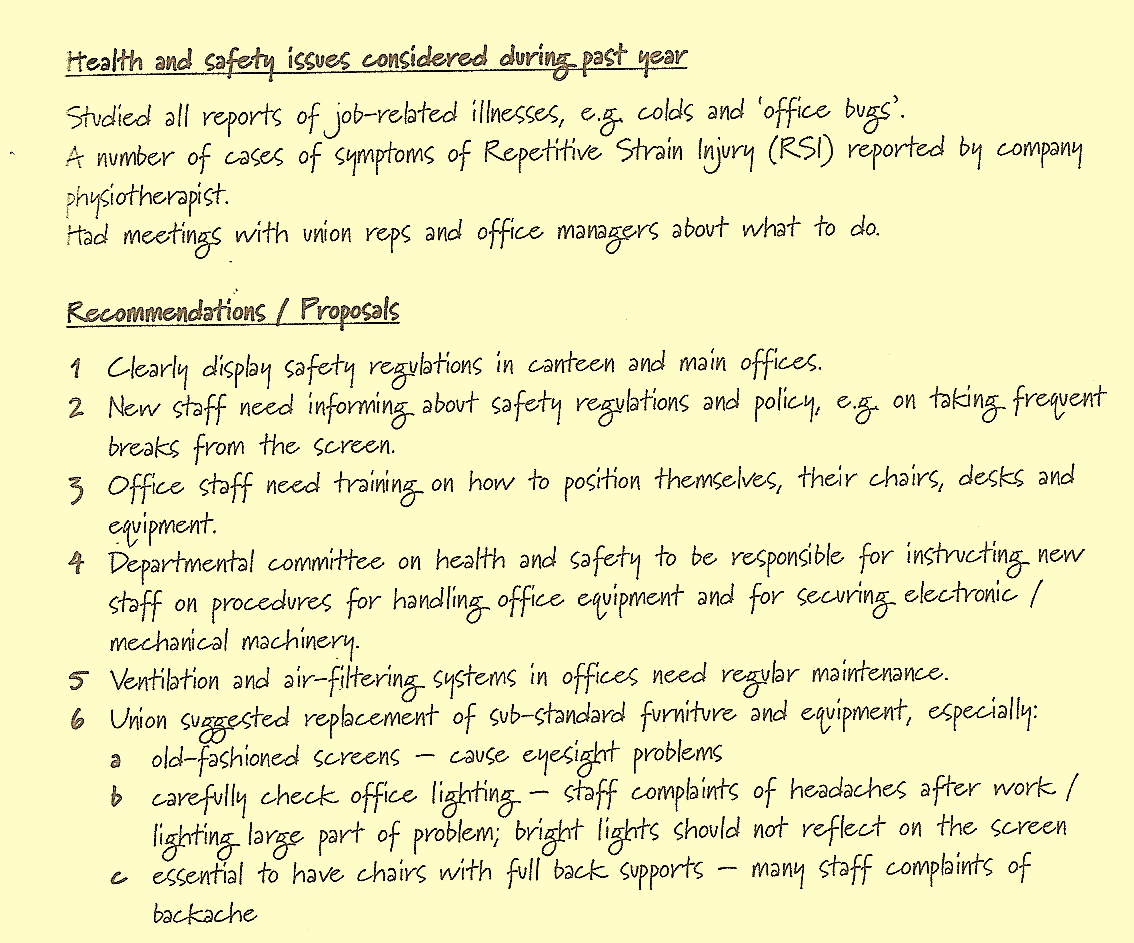
Begin your report like this:
To: Mr. Renoir, Managing Director
From: (your name) Date:
Office health and safety provisions
As requested by the Managing Director on 30 March 2010, I have investigated the problems which have been raised concerning office health and safety.
Compare your draft with your partner’s. Then look at Key section for a suggested draft. Compare your own report with it.
Task 2
Choose one of the topics. Then following the recommended steps write the draft of the essay. Look at the key section and read the sample essays on these topics. What differences are there between your essay and the sample?
Sample Essay Topic 1
Do you agree or disagree with the following statement?
Some people place a high value on loyalty to the employer. To others, it is perfectly acceptable to change jobs every few years to build a career. Discuss these two positions. Then indicate which position you agree with and why.
Sample Essay Topic 2
Students who live away from home while attending classes face the task of choosing housing accommodation. Some live in dormitories; others prefer living alone in apartments. Explain the benefits and disadvantages of the different options and support the option you prefer.
Sample Essay Topic 3
A writer has accused teachers and parents of causing children to develop ‘calcuholism’ – a reliance on calculators and resulting loss of mathematical ability. Describe what you believe the writer means by ‘calcuholism’ and what you believe causes it. Also state what you believe can be done to alleviate the problem.
|
|
|
|
|
Task 1
Choose one of the articles and take the following steps:
read the article.
identify the main points.
write down 10 questions.
make the vocabulary card (new words, expressions, idioms, etc).
prepare and make one-minute presentation on the issue discussed in the article.
1
How to Write a Business Report
Business report writing is used by professionals to write business research, forecasting and business related issues. This article will help you understand how to write a business report.

A business information report endeavors to make the reader understand the business plan, business growth strategies and the goal of your business. Business report writing is meant for an audience that is internal as well as external. These audiences are either from technical background or non-technical background. Business report writing can be a tedious tasks for those who find it extremely difficult to organize and write a detailed report.
It is very important to follow a proper format when writing business reports. There are standard business report writing formats that can be easily understood by anyone reading it. These sample business report formats also help reduce your time of preparing one as it helps you to become more organized. These sample business report
formats have been developed by professionals over the years. These well-written business writings also do not waste the time of the reader and do not allow them to skip the information that they should be reading. If you are wondering about how to write a business report, then read on further. The following business report example will help you understand how to write a business report.
Writing Business Reports
Business report writing involves use of logical steps that explains the information and data regarding the business related issues. The following sample business report will explain the major constituents of business information report.
Title Page: The title page includes the name of report, the author's name and date. You can also write the reason of report on the title page to inform the reader regarding the problems or solutions offered.
Letter of Transmittal: This is used to announce the release of the business report and give the reader the necessary background of the business information report.
Content Page: This page includes the table of contents of the major titles or heading mentioned in the report. You should include the letter or memo of transmittal in the table of contents. If there are sub headings in the report, try to include them too. You should mention the page number on which the main heading and sub heading lies. The page numbers should be written an inch from the bottom of the page.
List of Illustrations: This page is used to mention the illustrations included in your business report. When the business report includes only figures, title the page "List of Figures" or if it includes only tables then mention, "List of Tables".
Executive Summary: The executive summary is used to summarize the background of the report in one page for managers who do not have time to read your business report. The executive summary should include purpose and scope of the report and also the major conclusions and recommendations suggested. Mention only the information that is worth writing in the executive summary.
Methodology: Explain the methods followed in your research to come to a valid conclusion. You need to mention if you did a group survey or searched for information through the internet or library or involved an outside agency to carry out the research for you.
Report Body: This is the major chuck of business information report when writing business information. The headings and page numbers should match according to the table of contents. The report body should contain:
Introduction: The introduction will explain your audience why they are given this report to read and what is covered in the main body.
Main Body: The heart of your report lies within the main body. All your important data and information that needs to be mentioned while writing a business report need to be covered in the main body. You need to put forth your best writing skills when writing business reports.
Conclusion: The conclusion will analyze your result and bring your business report together. This is the answer to your business report, and will be read by everybody. Keep the conclusion short and to the point.
Recommendation: This will provide your reader the possible suggestions that will help address the issues mentioned in the business report. You should mention the recommendations using bullets and numbered points when writing a business report. You should be thoroughly sure about the recommendations made as they may be followed by the reader.
Appendix: You need to mention all the sources of research in detail. These details will prove helpful in supporting your recommendations.
This sample business report guidelines will help in writing business report that is concise and easy to digest. You should include all the relevant and important data in the start of the paragraph as people don't have time to read the entire page and hunt for information. Always keep a back-up of the data and research material as you may need it support your findings. You should make two copies of your report. Proof read the first copy and make appropriate changes and submit the second corrected copy of your business report. You can always search for business report examples on the Internet to help you format your business report. Business report can help make an impression on your audiences, thus, be very professional and precise when writing one. I hope these writing tips have solved your query how to write a business report.
2
To Make a Long Story Short: Summary Skills for Better Readers and Writers |
|
|
|
AA: I'm Avi Arditti and this week on WORDMASTER: our guest is Emily Kissner, a schoolteacher in Pennsylvania and author of a book called "Summarizing, Paraphrasing and Retelling."
|
|
"And then you need to condense those main ideas. You need to get rid of the repeated ideas. You need to exclude the trivia, those little details that are in there to keep you interested but really don't contribute to the main idea."
AA: "And then from there, you've boiled it down, you're looking for the important ideas, how do you begin to put them down on paper?"
EMILY KISSNER: "Different readers use different methods. There's been a lot of research on retelling, which is where you just retell the important ideas to someone else. Even without someone telling you it's good or bad, retelling what you've read changes something about how you store the information in your brain and helps you to understand it better. So one great way to start summarizing is just to turn to someone else and say 'Hey, I just read this, listen to what the author's talking about.'
"And from there, you can maybe list some of the main ideas. And then if you need to write a formal summary to give to someone else, you can kind of look for the connections between those ideas and then use those to frame your summary."
AA: "You write in your book here, you say: 'Left to their own devices, most students write the topic of a text when they're asked to write a main idea.' Now what's the difference between the topic and the main idea?"
EMILY KISSNER: "The topic is usually just one word or phrase to which everything in the text refers. So, for instance, if you were reading about dinosaurs, the topic of the book could be 'dinosaurs.' A main idea is usually a sentence that explains why the topic is important or explains something about the topic. So one article about dinosaurs might be 'dinosaurs evolved to many unusual creatures.' And so then everything in the text would go back to that main idea."
AA: "Do you find these techniques of summarizing to be helpful at all, or especially helpful, to English learners?"
EMILY KISSNER: "Where I teach right now, we actually have quite a significant population of students who are learning English, and one method that I found especially helpful for them was looking for key words in the article or the text. And so we would kind of develop their background knowledge first, and then they would look for key words that were important.
"And using some of these techniques like finding the main idea and looking for the structure of the text helped them to -- by the end of the year, they were writing some really competent summaries. And that really shows they were understanding the texts."
AA: "What would a bad summary look like?"
EMILY KISSNER: "A lot of students, and a lot of adults, use what's called the copy-and-delete method: 'Oh geez, I have to write this summary. I don't really know how. I'm just going to go through and pick up a few sentences here and a few sentences there, copy it down, I'll leave out a few sentences, and I have something that looks like a summary.' So when you're seeing a lot of text that's directly taken out of the main article, you can tell that the writer of that summary isn't working with very effective strategies for summarizing."
AA: "Now what's the difference between summarizing and paraphrasing? Since the title of your book is 'Summarizing, Paraphrasing and Retelling,' what's the difference?"
EMILY KISSNER: "Paraphrasing is just putting ideas into your own words. So, for instance, you could read a paragraph about global warming and you could paraphrase it and it could be just as long as the original paragraph. The key part with paraphrasing is that it's in your own words. With summarizing, you have a more formal product that is shorter than the original text."
AA: No one says any of this is easy, even for teachers. Emily Kissner recalls the day she told her students about her book.
EMILY KISSNER: "And then one kid just looked at me, and raised his hand and with a kind of sly smile said, 'Missus Kissner, could you summarize the book for us?' And suddenly I was put on the spot and I had to put all of what was in the book to the test to try to summarize this book in a way that the students could understand."
AA: "And did you pass the test?"
EMILY KISSNER: "Well, I think I did. [Laughter] It's hard to do on the spot."
Task 2
Choose one of the articles and render in in English
1 Успішне ділове листування Професійно написаний діловий лист може зміцнити ваші комерційні зв'язки, значно підняти престиж вашої компанії в очах ваших перспективних клієнтів, і покласти гарний початок вашій справі. Непрофесійний лист може стати причиною втрати інтересу до вас з боку ваших перспективних клієнтів до вашої продукції чи послуг, і може дорого вам коштувати. Ділові листи зазвичай поділяються на три категорії – ознайомлювальні листи, уточнюючі листи і супровідні листи до пакетів з інформацією. Як видно з назви, ознайомлювальні листи використовуються, щоб представити себе перспективним клієнтам і повідомити їм, що ви збираєтеся зв'язатися з ними у визначений день і час. Уточнюючі листи служать, щоб уточнити умови контакту, обговорені в попередньому листі: це може бути телефонна бесіда або особиста зустріч. Супровідні листи посилають як частину більшого пакету, вони несуть інформацію одержувачу про те, що шукати в такому пакеті. Нижченаведені поради допоможуть вам складати успішні ділові листи: Пишіть про вашого клієнта, а не про себе Найменш привабливе слово в діловому листі - "я", а найефективніше слово - "ви". Ніколи не починайте лист з "я", тому що читач, можливо, ніколи не прочитає друге слово Змініть "Я можу навчити ваш обслуговуючий персонал новітнім методам задоволення потреб клієнтів" на "Скарги ваших клієнтів скоротяться, якщо ваш обслуговуючий персонал буде навчений новітнім методам задоволення потреб клієнта". Надайте інформацію чи нагадайте одержувачу про себе Як правило, необхідно почати ваш лист з короткого введення про те, ким ви є і чим займаєтеся. Це є невід'ємною частиною ознайомлювального листа, але якщо ви вже говорили з цією людиною і він вас знає, відновіть враження від попереднього контакту. Наприклад: "Розмова з вами в минулий четвер була дуже важливою. «Екми Партнерз» - рекламне агентство, що може допомогти підвищити відвідуваність вашого веб-сайта за допомогою цілеспрямованої рекламної кампанії". Використання списків Ваш лист має включати приблизно три ключових пункти, виділених окремо. Читачам подобається поділ на пункти, тому що це робить лист легким в прочитанні. Як автор/продавець, ви отримаєте вигоду, чітко вказуючи найважливіші пункти, які ви хочете здійснити. Закінчуйте лист описом дій Якого результату ви хочете досягти вашим листом? Чи хочете ви призначити особисту зустріч з адресатом? Чи відповідаєте на питання, що виникли на попередній зустрічі? Чи хочете ви краще інформувати потенційних клієнтів? Ви повинні отримати підписаний контракт? Ваш лист містить інформацію про визначені дії? Наприклад: "Я зателефоную вам у вівторок, 18 листопада о 10 ранку, щоб призначити зустріч" чи "Будь ласка, поверніть контракт, що додається, у п'ятницю, 12 грудня, чи зателефонуйте мені, якщо у вас виникнуть будь-які інші питання". Будьте стислим Рідко хто збирається читати щось крім першої сторінки, тому скоротіть ваш лист до однієї сторінки. Багато одержувачів негайно дивляться в кінець сторінки, щоб побачити, чи є там підпис, щоб знати, від кого прибув лист. Необхідність уміститися на одній сторінці також змусить вас бути точним, тому що хаотичний лист - неефективний лист. Покажіть, що ви розумієте їхню компанію Ви негайно заслужите довіру, якщо покажете, що ви прекрасно розбираєтеся у всіх нюансах діяльності компанії вашого клієнта. Це особливо важливо, коли ви хочете здобути великого корпоративного клієнта. Коротко поговоріть про їхню марку, імідж і потреби. Наприклад: «Екми» має репутацію партнера, що забезпечує чудове обслуговування і ставить на перше місце потреби клієнта» чи «Це величезна відповідальність бути власником «Аякс віджета». Поділіться ідеями Ваш діловий лист, по суті, є дуже короткою діловою пропозицією, тому ви повинні показати, що ви думаєте про потреби ваших потенційних клієнтів. Ви можете вагатися, чи оголошувати ваші кращі ідеї в листі, побоюючись, що ваші потенційні клієнти використають їх і не стануть співробітничати з вашою компанією. Це - помилка. Повідомляючи ваші ідеї в листі, ви змусите ваших потенційних клієнтів відчути, що вони вже отримали дещо, і що вони матимуть користь з вашої продукції чи послуг. Що важливіше, ви продемонструєте свої творчі здібності, компетенцію в даній області і важливіс |
|
ть для вас інтересів вашого потенційного клієнта. Попросіть когось перечитати лист Нехай ще одна пара очей перегляне лист, перш ніж ви відправите його. Це допоможе вам визначити, наскільки зрозумілим є ваш лист, і чи досягли ви бажаного ефекту. Також попросіть, щоб ця людина пошукала помилки; адже ви не хочете зазнавати невдачі в бізнесі через невірно написане слово чи іншу необережну помилку. |
2

